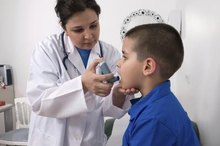Why Does a Sudden Change in the Weather Cause Sickness?
Every change in weather sends a new round of people to the doctor. But are these sicknesses real or imagined? Some claim that weather causing illness is an old wives' tale--and they may be right. People get sick from bacteria and a weak immune system, not from temperature. But weather changes can cause symptoms that are just as aggravating as the real thing.
The Theory
Weather alone can't make a person ill, but changes in weather are accompanied by a host of other changes that can give a person flu symptoms. Your body is used to functioning in a certain temperature, so as the seasons change, your body is forced to re-adapt. This includes your immune system, making you more vulnerable to infections and viruses.
Misconceptions
Does Working Out in the Rain Make You Sick?
Learn More
When a tropical storm hits, it can make people feel ill. Why doesn’t a hot shower do the same? The reason is that it is not the rain or temperature alone that brings about infections. Cold weather gives people runny noses but not a cold, and getting caught in the rain may give people the chills but not a fever. Although weather doesn't directly result in sickness, the symptoms it causes can still leave people feeling under the weather.
- When a tropical storm hits, it can make people feel ill.
- Although weather doesn't directly result in sickness, the symptoms it causes can still leave people feeling under the weather.
Example
So why does a storm make people feel ill? When a storm hits, it causes a drop in atmospheric pressure, which can lead to symptoms such as migraines. Your body learns to function in a certain pressure, and when that changes, it can wreak havoc on your system. This is why people suffer altitude sickness and decompression illness, and in stormy weather, people may find themselves similarly suffering.
- So why does a storm make people feel ill?
- This is why people suffer altitude sickness and decompression illness, and in stormy weather, people may find themselves similarly suffering.
The Facts
How Humidity Causes Joint Pain
Learn More
Cold weather means more indoor activities, and when people are cooped up inside rooms together with the windows closed, germs are more likely to spread. People don’t get as much fresh air as they do in warmer weather, and they may not be as apt to exercise in the cold.
Meanwhile, hot weather means more outdoor activities, which can cause allergies to flare. Pollen in the air often aggravates respiratory problems, irritating existing conditions such as asthma or causing new problems. Dehydration can lead to headaches and heatstroke 1. These cases send people to the doctor just as much as cases of the flu or colds do in winter.
- Cold weather means more indoor activities, and when people are cooped up inside rooms together with the windows closed, germs are more likely to spread.
Prevention
Nutrition, exercise and hygiene can boost the immune system while the weather changes. Getting enough vitamin C is essential for warding off colds. Zinc, found in foods such as:
- oysters
- shellfish
- all bran cereals
- helps the body make more T-cells
- which fight infection
Exercise lowers stress levels that make people vulnerable to viruses, and it may increase the circulation of cells needed to fight infection. And in all temperatures, washing your hands frequently can prevent the spread of the bacteria that causes illness in the first place.
- Nutrition, exercise and hygiene can boost the immune system while the weather changes.
Related Articles
References
- How to Handle the Dreaded Barometric Pressure Headache!
- Bennett RM, Jones J, Turk DC, Russell IJ, Matallana L. An Internet Survey of 2,596 People With Fibromyalgia. BMC Musculoskelet Disord. 2007;8:27.
- Bossema ER, Van Middendorf H, Jacobs JW, Bijlsma JW, Geenen R. Influence of Weather on Daily Symptoms of Pain and Fatigue in Female Patients With Fibromyalgia: A Multilevel Regression Analysis. Arthritis Care Res (Hoboken). 2013;65(7):1019-25.
- Delir Haghighi P, Kang YB, Buchbinder R, Burstein F, Whittle S. Investigating Subjective Experience and the Influence of Weather Among Individuals With Fibromyalgia: A Content Analysis of Twitter. JMIR Public Health Surveill. 2017;3(1):e4.
- Macfarlane TV, Mcbeth J, Jones GT, Nicholl B, Macfarlane GJ. Whether the Weather Influences Pain? Results From the Epifund Study in North West England. Rheumatology (Oxford). 2010;49(8):1513-20.
- Timmermans EJ, Schaap LA, Herbolsheimer F, et al. The Influence of Weather Conditions on Joint Pain in Older People with Osteoarthritis: Results from the European Project on OSteoArthritis. J Rheumatol. 2015;42(10):1885-92.








